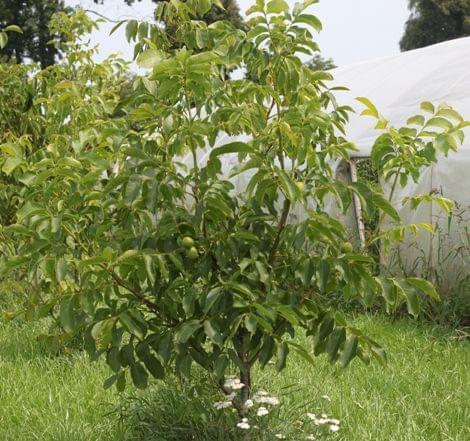 WALNUT
WALNUT
Walnut and its varieties form large trees, growing up to height 25 m. They form loose crowns, wide-spread. That's why, even though it has valuable fruit, it is not recommended for growing on a plot. Walnut planted on the plot, especially in good soil, it grows to enormous sizes and takes almost a few years later 100 m2 of space, i.e. approx. 1/3 average plot. The walnut is a beautiful and useful tree, therefore prof. Dr Alexander Reyman [18] recommends planting it on any larger home or recreation plot, with deep and fertile soil. The fruits of the walnut contain 60-70% fat, 17-24% proteins and large amounts of vitamins: A, B,, B2, and C. Green fruit, before hardening of the casing, they are used to make vodkas and liqueurs, and their extracts are used in tanning and paint production. Walnut as a gentle tree, and even a warm climate, it is not resistant to low temperatures. It freezes in severe winters, when the temperature drops below -25 ° C. It is also sensitive to frost. A drop in temperature to -1 ° C during flowering may already destroy the flowers, especially male. Walnut has dioecious flowers, but single-skinned, that is, on one tree there are both male and female flowers. Male flowers, gathered in kitties, they grow singly or in greater numbers from leaf axils. Female flowers, collected in cluster inflorescences, most often 1 2- or 3-flower, they are set on the tops of one-year-old shoots. The walnut blooms in May.
Walnut seedlings planted in the garden usually bear fruit quite late, because only in 10-15 age. On average, a tree in 16-20 year spends approx 10 kg of fruit, in 21 -30 year approx 25 Kg, and in 31-45 about 45 kg and more nuts. Some selected types (varieties) In favorable years, walnuts bear fruit much better and enter the fruiting period earlier. Wanting to receive earlier and more fruitful walnuts, it is necessary to apply vegetative reproduction by grafting or budding selected cultivars with valuable production-related traits. Unfortunately, in our climatic conditions, grafting and budding give good results only in a greenhouse or under laboratory conditions. One-year rootstocks, vaccinated in the greenhouse in early spring, are planted in the ground in May.
When we want to produce a walnut tree on our own, walnut harvested in autumn should be used – after removing the green cover and drying it – in December, put it in damp sand and keep in a cool place at 2-4 ° C for three months. Early spring – preferably at the end of March – we sow nuts into the ground, placing them at depth 6-7 Cm, in rows what 10 Cm. Walnut trees are best planted in the fall. They should be planted a few cm deeper than they grew in the nursery. This method of reproduction causes, that we do not have varieties of walnut.
Walnut diseases and pests
Among the diseases affecting the walnut, they are the most dangerous: nut brown spot caused by fungus and black spot (caused by bacteria) so damaging the leaves, and fruit. The extent of the disease can be limited, spraying trees in early May, before flowering and after flowering (0,1%) Copper solution 50. It is also advisable to rake and burn fallen leaves, on which the fungus hibernates.
Emerging nut aphids, the so-called. ornaments are fought with the same means, which are recommended for the protection of other fruit trees, for example. pyrimor 50 DP, Anthio, Sadophos col. 30.
Scale wounds appear quite often on the trunks of older walnut trees, caused by large temperature fluctuations in the early spring. The bleaching of the trunk prevents the formation of gangrenous wounds (in December).